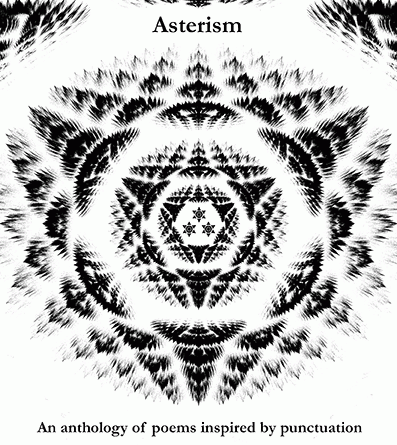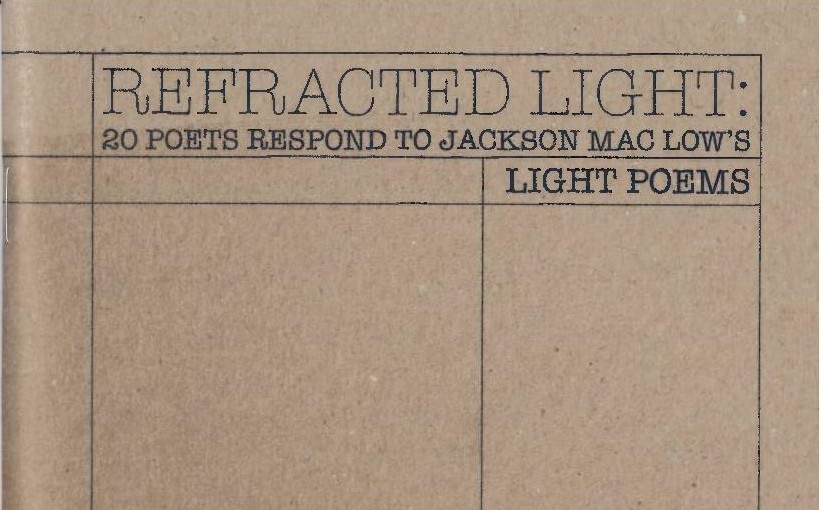Asterism: An anthology of poems inspired by punctuation ed. by Tiffany Anne Tondut
– Reviewed by Jennifer Edgecombe –
An Asterism ⁂, as well as being the word for a pattern of stars or ‘an optical phenomenon in gemstones’, is also ‘used to indicate minor breaks in text [or] to separate sub-chapters in a book’. Used as this anthology’s title, the asterism acts as metaphor: this punctuation mark that starts, halts or ends a flow of text is also a poem. This anthology, published by Laudanum, collects poems that celebrate, highlight or question a variety of punctuation marks. It features a cast of thirty-seven poets, ranging from Simon Barraclough and Julia Bird to Philip Terry and Edward Venning, alphabetically sequenced (by first name) in parts entitled ‘Punctuation’, ‘General Typography’, ‘Uncommon Typography’, and ‘Intellectual Property’.
Embracing an experimental approach, Asterism illuminates formal rules that are often disregarded or taken for granted. As with most ‘writing on writing’, humour and self-reflection/mockery can appear, as in Amy Key’s poem, *. She begins to note the character’s perfunctory role, then leaps into inventive images:
The asterisk is most often visible in the absence of something else. It is sudden perfume. […] consider ornamental air vents, earring, disco boots and so on.
Key’s speaker then turns sour, decides to turn on this mark, and sounds a warning note:
… the asterisk has fingernails, those fingernails are tipped with flint daggers. The centre of the asterisk is a plughole you need to pull a clot of hair out of. Known for its outbursts the asterisk must be deployed with caution, if at all.
I agree with Key’s poem, for I have sometimes seen asterisks used too freely. Within poetry classes, punctuation is sometimes the first and easiest formal rule that writers suggest changing in order to develop a poem: it feels simpler to amend than changing to a different form or attempting a restructure. Sometimes this leads to a better poem, a looser verse or a narrative allowed to cascade without stopping. However, I love the way in which this anthology enforces the notion that punctuation remains essential to poetry, and can/should be used to experiment with form and topic.
One of my favourite poems that achieves this is by Harry Man, titled ‘Orwell’s Nineteen Eighty-Four in 198 Hashtags’. It offers a highly ironic and brilliant use of form, given that 1984 predicts that technology will lead society into a ‘Big Brother’ state of constant surveillance and social media tools, Twitter or Instagram, are perfect examples of how this is now happening. These platforms led to a new usage of the hashtag #, first used as a metadata tagging tool, then developed into a symbol of expression, often to define the Tweet or picture itself. One could argue that hashtags are the newest formal expressions of metaphor. The poem begins:
#qualitytime #winstonsmith #airstripone #post
#civil #revolution #england #hateweekdays
#oneroomapartment #instafood #syntheticmeals #class
Man progresses by adding new words that have been invented via social media: ‘#past #information #place #amwriting’ and ‘#society #brotherhood #destroy #besties’. I love the use of the hashtags ‘#roomies’, ‘#shoutout’ and ‘#shoppingonline’ which painfully contrast what is really happening within this Orwellian dystopia.
Another brilliant example of punctuation used to experiment with form and subject is Hannah Lowe’s poem, -. Using a bold font on the left half of the page and a standard font on the right, Lowe hyphenates the poem into two separate poems thematically and aesthetically linked as if with a hyphen, as this example from the first few lines illustrates:
All that summer, he floated like a prophet Someone has to make decisions
on their placards: Free Mumia! Free Abu-Jamal! In a small office, women
Dread-locked and gaunt in death row orange with marker pens and reams
There are too many great poems in this collection to be able to credit them all, but another highlight is Camellia Stafford’s poem, ~, which perfectly describes the action of the tilde mark within these simplistic but incredible opening lines: ‘The equivalent of this moment is how it ought to be. / Too much is unchanged. Nothing’s the same.’ Jon Stone achieves the same effect in his poem, ‒, with this ending:
But mostly it’s a stitch
or an outstretched figure
freezeframed mid-leap between carriages,landing us
on another burning train.
Overall, this is a fantastic collection for anyone interested in stigmeology (what joy to be re-introduced to the interrobang and conduct a long internet search finding out more on the lozenge), the best of contemporary and experimental poetry, or in modern form and technique. As a new, innovative publisher, Laudanum are dedicated to both promoting new voices and giving established poets room to experiment within their combined-author chapbook series. I congratulate their success as a new small press in this field, and look forward to reading more.




